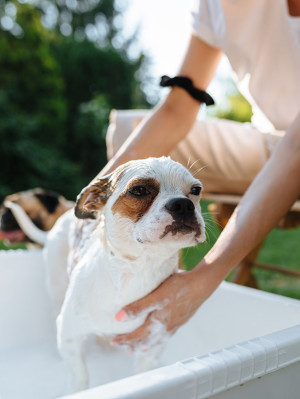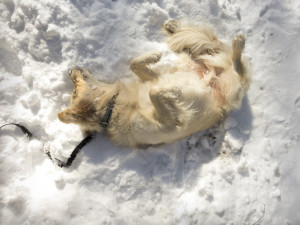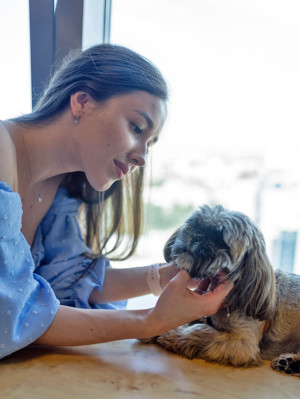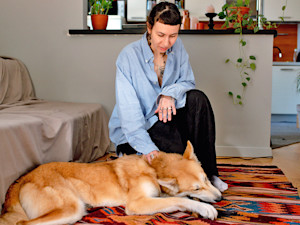Can Dogs Have Alopecia?
And what to do about it.

Share Article
In This Article:
Why Is My Dog Losing Hair? Alopecia in Dogs What Causes Alopecia in Dogs? Dog Breeds Prone to Alopecia
Many people take great pride in the health of their dog’s coat, so the sudden appearance of thin or bald areas often causes great concern. While the cause is sometimes obvious (like a dog chewing bald patches due to fleas), pet parents may be left thinking, “My dog doesn’t have any skin irritation and nothing has changed recently. She seems healthy otherwise, so why is my dog losing fur on her back and thighs?”
Why is my dog losing hair?
Alopecia can be caused by genetic factors, parasites, inflammation, , autoimmune diseases, and infections. Getting to the bottom of what’s causing hair loss in a dog requires work-up with a veterinarian or veterinary dermatologist. Some types of alopecia can be treated successfully, while others will persist for life.
One common way to classify alopecia in dogs is by itchiness. Yes, I’m serious. Pruritic alopecia (with itchiness) tends to be due to self-trauma, meaning that the hair is lost due to the dog scratching or chewing the itchy area. Itchy skin lesions are often due to parasites (like fleas, mites, or lice), allergies, or infections with yeast or bacteria. Treating the underlying cause of the itch allows hair to regrow in the area without being damaged.

It can be tougher to figure out the cause of non-pruritic alopecia (hair loss with no itchiness). This type of hair loss often goes completely unnoticed by the dog. These conditions often result from hair follicle abnormalities, hormonal imbalances like diabetes or high cortisone, or disruptions in the hair growth cycle. Skin biopsies may need to be reviewed by a pathologist that specializes in skin disorders to definitively diagnose the cause. Many genetic causes of alopecia do not have effective treatments to restore hair growth.
While most pet parents worry about their dog losing hair, some types of baldness aren’t a surprise. Alopecia is an inherited feature of some dog breeds like the Xoloitzcuintli (pronounced “show-low-eats-QUEENT-lee,” but often referred to as the Mexican Hairless), Chinese Crested, American Hairless Terrier, and Peruvian Inca Orchid. Despite these breeds being best known for their hairlessness, they all come in hairless and coated varieties, meaning there are some hairy American Hairless Terriers out there. They’re still pretty sleek looking.
Alopecia in dogs
“Alopecia” is a very general term that covers loss of hair on any part of the body that is normally haired. For dogs, this is most of their body. Even small areas of alopecia are obvious on short-haired dogs, but similar spots may go unnoticed on long-haired dogs. Any hair loss is considered abnormal, so it’s best to get any bald spots checked out by your vet.
Dog alopecia may be accompanied by other symptoms, such as:
Hair color changes
Crusting or scaling of skin
Darkening of skin color
Lightening of skin color
Inflammation
Discharge
Open wounds
Your veterinarian will consider the appearance of the area of hair loss, your dog’s age, preexisting health conditions, blood work findings, skin cytology, and skin scraping results to help determine the cause of alopecia. While basic diagnostics can help pinpoint many causes of hair loss in dogs, biopsies may be needed to obtain a definitive diagnosis.
What causes alopecia in dogs?
There are many causes of alopecia in dogs, and many of the conditions look the same externally but are characterized by subtle microscopic differences. Getting into the weeds of the varieties of hair follicle disorders might put both of us to sleep, but knowing some general causes and types of alopecia can help you think about what could be causing your dog’s bald spots.
Allergies
Allergies are one of the most common causes for localized hair loss in dogs. Skin allergies can be triggered by food, direct contact, insect bites, or inhalation. Allergies cause skin inflammation and often result in intense itchiness, leading to self-trauma and hair loss. Damaged skin is predisposed to secondary infection by bacteria or yeast, worsening inflammation.
Parasites
Skin parasites like fleas, ticks, mange mites, and lice can all cause alopecia in dogs. These tiny pests may damage hair follicles or cause intense itching that results in self-trauma. While finding fleas is easy, diagnosing some mange mites can be challenging. Fortunately, eliminating and preventing parasites is easier than ever with modern monthly flea medications.
Skin infections
Bacteria or fungi can cause significant skin infections in dogs. They may be contagious (like ringworm) or develop due to disruption of a healthy skin barrier (like hot spots). Fortunately, most skin infections can be eliminated with topical or oral medications, and hair generally regrows once the infection is under control.
Endocrine disorders
Diseases like hypothyroidism and Cushing’s disease (hyperadrenocorticism) may cause symmetrical (both sides of the chest) or widespread alopecia. Dogs with hypothyroidism will often be missing a triangle of hair just behind the velvety part of the top of their nose. The hair may have a dry, dull appearance and come out easily when pulled. Dogs with these conditions often have trouble regrowing hair after it is clipped.
Cyclic flank alopecia
Flank alopecia in dogs often follows a seasonal cycle. Dogs will lose hair and have darkened skin along their sides in the autumn or spring, then regrow the hair during the summer and winter. The hair sometimes comes back a different color when it regrows. Seasonal alopecia in dogs may be a one-time thing, or it can recur and become more severe each year.
Hair follicle disorders
Dogs are always growing new hair. Old hair falls out and new hair should come in to replace it, with some seasonal variation in the amount of growth. Alopecia can result from problems with the structure of hair follicles, the way they respond to hormonal stimulation, or the development of a hair shaft within the follicle. Disorders like alopecia X, post-clipping alopecia, color dilution alopecia, black hair follicular dysplasia, bald thigh syndrome, and pattern baldness alopecia can affect several different dog breeds.
Dog breeds prone to alopecia
Many causes of alopecia in dogs are linked to genetics, so it’s not surprising that some breeds are predisposed to hair loss. Your dog’s lineage may be to blame if you’re wondering, “Why is my dog losing hair?” An exhaustive list of dog breeds that are predisposed to problems with alopecia would be extremely long because there are so many conditions that can cause hair loss. Some of the more common breeds that can have issues with alopecia include:
Boston Terriers
Dachshunds
Chihuahuas
Greyhounds
Pomeranians
Standard Poodles
Siberian Huskies
Boxers
Bulldogs
Doberman Pinschers
When to seek expert help
While a bald patch is rarely an emergency, it’s always best to get problems with your dog’s coat checked out by your veterinarian. Changes to the consistency, color, luster, or fullness of a dog’s hair could indicate a systemic disorder. Your veterinarian may be able to help you find solutions to your dog’s hair loss or institute treatments to improve the appearance of your dog’s coat.
Bottom line
Dogs can develop hair loss due to problems on the surface of their skin, issues with their hair follicles, or the onset of systemic diseases. Your dog’s symptoms (including itchiness) and the pattern and seasonality of their alopecia could indicate the cause. Some causes of alopecia are treatable with parasite control, dietary supplements, topical therapies, or medication. Some genetic causes of alopecia do not have any effective treatments, but they can give your dog the opportunity to try out some fashionable outfits to stay protected from the sun and cold.
References
Bloom, Paul. “Nonpruritic alopecia in the dogopens in new tab” DVM360 April 1, 2009.
Welle, Monika M. “Canine noninflammatory alopecia: An approach to its classification and a diagnostic aid.” Veterinary Pathology vol. 60,6 (2023): 748-769. doi:10.1177/03009858231170295opens in new tab.
Brunner, Magdalena A T et al. “Bald thigh syndrome in sighthounds-Revisiting the cause of a well-known disease.” PloS One vol. 14,2 e0212645. 22 Feb. 2019, doi:10.1371/journal.pone.0212645opens in new tab.

Dr. Bartley Harrison, DVM
Dr. Bartley Harrison is a veterinarian with more than 19 years of experience. He has treated a variety of species in emergency and speciality practices for both large and small animals. His primary interests as a vet are emergency medicine and critical care.
Related articles
Can Dogs Get Pimples? Causes, Symptoms, and Treatments
Time to go to the doggie dermatologist!
Can Dogs Get Skin Tags? Causes and Treatments
Yes, and here’s why you shouldn’t pick at them, even if you want to.
Can Dogs Get Sunburns? Signs, Treatment
It’s good to know ahead of all the summer fun you’re gonna have together.
What Can I Wash My Dog With?
They would prefer no bath at all, but we’re not asking them.
![Woman rubbing her dog's back at home.]()
Why Does Your Dog Have Bumps on Their Back?
Hmm, those weren’t always there...
Can Dogs Get Scabies?
And what to look for if you think your pup has them.








